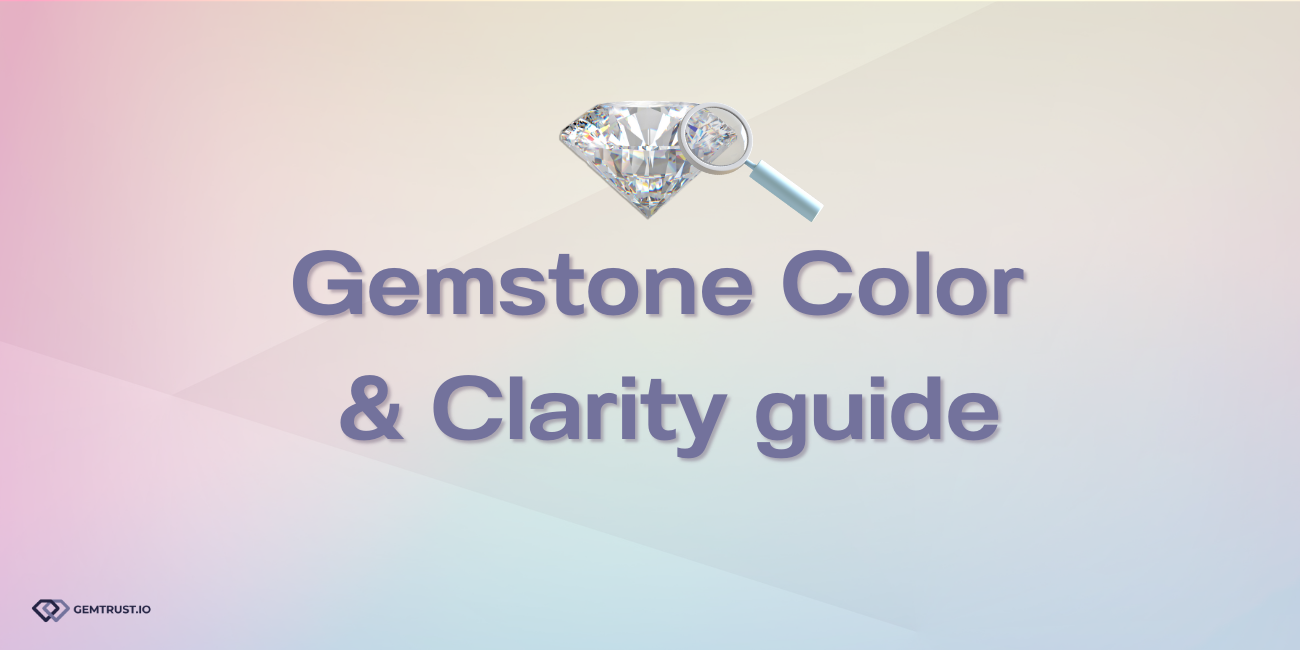
Gemstone Color and Clarity Guide
Gemstone color and clarity guide
COLOR
Color refers to any of the hues of the visible spectrum perceived by each individual. Humans are capable of differentiating over two million hues. Each person perceives color differently and the concept of color is a highly personal one. It is not possible for color blind people to understand the sensation of the color that he or she cannot see.
Color is also one of the first things you can see in a gem. It is considered by many to be one of the most important aspects in determining the quality of a colored gem.
There are three attributes of color b which it can be described. They are hue, tone and saturation.
Hue refers to all the colors such as red, yellow, blue, green, pink, etc. Hue is synonymous with color.
In an attempt to determine color grade, we have assigned a numerical grade or range using numbers between 1 and 10.
Tone refers to the degree of lightness to darkness of a particular hue. To visualize this idea, picture two glasses each half-filled with water. Now, take two drops of ink and mix it to each glass. The two glasses have the same hue and the same tone.
Now, add two more drops of ink to one of the glasses. You can see that the tone has increased by fifty percent in one of the glasses although they continue to have the same hue.
The third attribute of color is saturation and refers to the vividness of a hue. Take for example the two glasses we spoke about earlier. By adding a drop of milk to one of the glasses you have effectively changed the vividness or saturation of the particular hue. Another example is to compare a read tomato and a red brick. They could both have the same hue but be of different saturation.
Saturation is given three is given possible descriptions on the AIGS Master Gemstone e- Report as: EXCELLENT, GOOD, FAIR
These three attributes of a color are widely used in the gemological field as well as in industries such as photography, paint, cosmetics, textiles and others.
As far as ruby is concerned, our gemologists have noted five basic hue types. It would be fair to say that hue-type is a matter of personal choice, and one is not really superior to the other. Generally speaking, people are attracted by bright vivid colors which are devoid of gray or brown overtones.
In an attempt to define color, tone is that attribute which determines the color’s position on a dark to light or black to white scale. To illustrate clearly the position of a tone, we have assigned numerical grades using numbers between 0 and 100.
’
The clarity of a faceted colored stone is a major factor in determining its quality and therefore, its price. Any inclusion or defect inside or on the surface of a gem will interfere with the behavior of light in the stone. This phenomenon effects the stone’s appearance, especially its brilliancy. The clarity grade is determined by the number of inclusions, Thier size, type, location and color.
Explanation and example of representative inclusions in each category follows:
FL (Flawless): To the unaided eye, no marks can be either internally or externally visible. Barely visible heat wave or “roiled” effect in Burmese ruby or barely visible color banding (not visible to the unaided eye) would be allowed in this category.
NFL (Near Flawless): Stones in the category may have very minor nicks, pits or inclusions which could be removed by simple polishing, or very small panicle type inclusions not under the table and not discernable in transmitted light.
LI 1 (Lightly Included 1) Inclusions in this clarity level are not noticeable to the unaided eye in reflected light
LI2 (Lightly Included 2): Stones in which the inclusions are slightly noticeable to the unaided eye in reflected light, but which do not detract from the appearance are found here. Examples might be very tiny inclusions or area of inclusions, healing planes, planes of silk, feathers or rutile needles.
MI 1 (Moderately Included): At this clarity level inclusions are noticeable but: do not detract from appearance. The stones may have minimal inclusions under the table, minor nicks on the pavilion or girdle outline, or very fine silk.
MI2 (Moderately included 2) Inclusions in these stones are noticeable
MI3 (Moderately Included 3): Some inclusions may be found under the table, but they should not detract from the stone’s appearance.
VI1 (Visibly Included 1): Inclusions in VII stones are noticeable and detract somewhat from the stone’s appearance.
VI2 (Visible Included 2): Inclusions are more noticeable in these stones than in VII stones.
HI (Heavily Included): These stones commonly have large and/or obvious inclusions, fractures, large cavities which are easily visible through the table, and/or coarse silk which may cause the stone to have a sleepy appearance.
*IMPORTANT LIMITATIONS : THE AIGS Star Rating and Master Gemstone e - Report (MGeR) is not a valuation, warranty or guarantee. Users of this MGeR wish to consult a reputable jewler or qualifies gemologist about the information contained therein. The color, clarity, cut grades, of the gemstone described in the e - Report represent rages of appearance. AIGS recommends the actual viewing of the gemstone rather than relying solely on the MGeR information before making purchasing decisions.
TAG Gem guide, color guide, clarity guide, color and clarity guide, inclusions, buy gems, sell gems.
